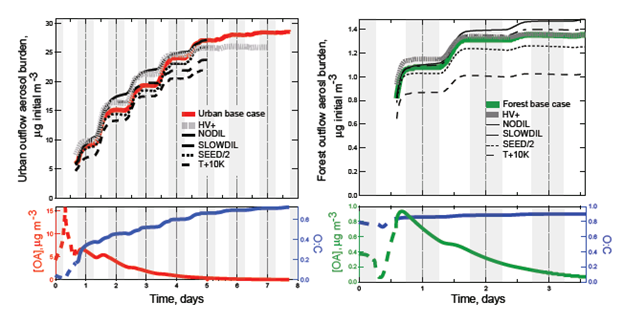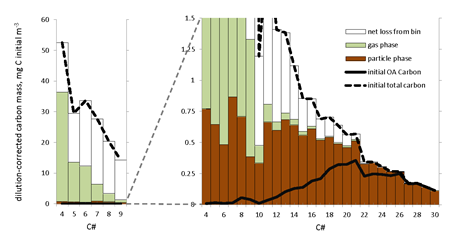Multiday production of SOA in urban and forest outflow
Secondary organic aerosol (SOA) production in urban and biogenic outflow was investigated using the explicit gas-phase chemical mechanism generator GECKO-A [Lee-Taylor et al., 2015]. Urban outflow simulations show several-fold increases in SOA mass continuing for multiple days, whereas forest outflow simulations showed only modest SOA mass increases, and no long-term growth. The multiday SOA production in urban-origin air stems from multigenerational oxidation products of gas-phase precursors which persist in equilibrium with the particle phase. The results imply that anthropogenic aerosol precursors could influence the chemical and radiative characteristics of the atmosphere over an extremely wide region, and that SOA measurements near precursor sources may routinely underestimate this influence.
The production of SOA particles may be understood – at least semi-qualitatively – as resulting from the condensation of low-volatility, partly oxidized organic compounds that are intermediates in the atmospheric oxidation of many hydrocarbons, both biogenic and anthropogenic. This complex chemistry is being simulated with GECKO-A (Generator of Explicit Chemistry and Kinetics of Organics in the Atmosphere). The model uses structure-activity relationships derived from compilations of laboratory measurements to estimate detailed chemical pathways and kinetics, and properties relevant to gas/particle equilibrium partitioning, and applies them in a box model framework. We performed multi-day sensitivity studies of SOA production centered on two main scenarios: an anthropogenic outflow scenario based on Mexico City during the MILAGRO (Megacity Initiative: Local and Global Research Observations) campaign of March 2006, with a precursor mix containing light aromatics, long-chain n-alkanes, and smaller alkanes and branched alkanes; and a biogenic outflow scenario based on Manitou Forest during the BEACHON-RoMBAS field campaign of summer 2011, with a precursor mix high in monoterpenes and low in aromatics, alkanes and alkenes. We found SOA mass increases in urban-origin air of >4-fold above near-source values over a timescale similar to OA depositional lifetimes (~ 1 week). SOA mass gains in biogenically-influenced outflow are more modest (~ 50%) and of shorter duration (1-2 days). The difference is primarily due to the relative timescales of gas-phase photochemical oxidation of aerosol precursors from the two source types, with significant contributions in the urban case from multigenerational reaction products of both aromatics and alkanes, especially those with relatively low carbon numbers (C4-15). In particular we find large contributions from substituted maleic anhydrides and multi-substituted peroxide-bicyclic alkenes. The results also show that the predicted production is a robust feature of our model even under changing atmospheric conditions and different vapor pressure schemes.
The multiday particle mass production we predict from explicit chemical considerations represents a large but diluting secondary source of anthropogenic SOA which is not easily discerned in concentration data. This has implications for the regional and global radiative forcing (RF) of climate by anthropogenic organic aerosols and points to the importance of considering, as explicitly as possible, the different timescales of chemistry leading to SOA formation from different precursor sources.

Figure 1: results from case studies based on ACD campaigns in Mexico City (MILAGRO, 2006, red lines), and in Manitou Forest (BEACHON, 2011, green lines). Upper panels show plume-integrated mass. Lower panels show concentrations and O:C ratios for the model-generated aerosol fraction.

Figure 2: Urban outflow carbon partitioning budget by carbon number, at simulation start (lines) and after 4 days (stacked bars). In that time, C10+ species undergo almost complete gas-particle partitioning or fragmentation, however smaller species (C<10) still have a substantial gas phase reservoir available for oxidation and potential further condensation.
Reference: Lee-Taylor, J., Hodzic, A., Madronich, S., Aumont, B., Camredon, M., and Valorso, R. (2015), Multiday production of condensing organic aerosol mass in urban and forest outflow, Atmos. Chem. Phys., 15, 595-615, doi:10.5194/acp-15-595-2015. [http://www.atmos-chem-phys.net/15/595/2015/acp-15-595-2015.html]
